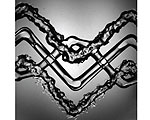Printing Blood Vessels with Disappearing Ink
 Mar-06-14
Using a ‘disappearing ink’ method, Harvard researchers have managed to create tissue with an interlacing of blood vessels—a significant step forward in the creation of artificial organs.
Mar-06-14
Using a ‘disappearing ink’ method, Harvard researchers have managed to create tissue with an interlacing of blood vessels—a significant step forward in the creation of artificial organs.Using a custom-built, four-head printer and an ‘ink’ that liquefies as it cools, the team created tube-like structures within a mesh network of printed cells. They 3D printed the tissue in layers, using a gelatin-based ink to form the extracellular matrix (the mix that surrounds the cells in the body) and another ink containing mouse or human skin cells. These inks are able to maintain their structure once they have been ‘printed.’
To create the hollow tubes, the team used an ink that has a consistency like Jell-O at room temperature, but will liquefy when it cools. Tracks of this ink were printed among the others, and then the bit of printed tissue was chilled, causing the ink to liquefy. When the liquid ink was removed using a light vacuum, empty channels were left behind. Cells that line the body’s blood vessels can then be embedded in the channels.

Add Your Comment